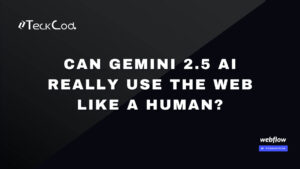The change in search is accelerated. Search Engine Optimization (SEO) has been the foundation of digital presence since the times when businesses have made their way up the Google hierarchy and acquired organic traffic.
However, there is a new trend, suggesting a new practice with the emergence of artificial intelligence: Generative Engine Optimization (GEO).
SEO will make your website appear in the search list. GEO, by contrast, has your content cited, trusted and referenced within AI-generated responses on sites such as ChatGPT, Perplexity, and AI Overviews on Google.
We will dissect the disparities between SEO and GEO, review the upcoming trends of 2025, examine the influence of various AI models on optimization, and detail why these two approaches can no longer be avoided to achieve long-term visibility in this guide.
What is SEO (Search Engine Optimization)?
SEO refers to the act of enhancing the visibility of a site through the use of search engines like Google, Bing or Yahoo, among the conventional search engines. It is meant to boost organic traffic as it is ranked higher in the search results when users key in relevant queries.
Core Elements of SEO
- Keywords: Researching and targeting the words or phrases that people search for. For example, someone looking for Top Ranked SEO Services might search “best SEO agencies in 2025.”
- Content Quality: Publishing valuable, well-structured, and engaging content.
- Backlinks: Gaining links from trusted websites to build domain authority.
- Technical Optimization: Ensuring fast load times, secure browsing, and mobile responsiveness.
Example
Take the case of a firm that has been providing a best web development services. The company can rank high in terms of such keywords as best web development agencies by optimization of the company pages with keywords, case studies and backlinks. This brings visibility, establishes trust and draws qualified leads.
What is GEO (Generative Engine Optimization)?
Generative Engine Optimization (GEO) is the act of ensuring content is optimized to appear in the responses generated in AI. Contrary to SEO, which aims at ranking links, GEO guarantees your content to be AI-ready, structured and authoritative, which increases the chances of being cited by ChatGPT, Perplexity, Gemini, or AI Overviews at Google.
Core Elements of GEO
- Clarity: Writing in direct, simple language that AI can easily interpret.
- Structure: Using headings, bullet points, and concise formats for easy extraction.
- Authority: Providing accurate, evidence-backed information to build trust.
- Freshness: Regularly updating content with the latest statistics and insights.
Example
Assume that a digital agency has posted an extended tutorial on webflow design workflows. When a user requests ChatGPT to answer the question, How do designers use Webflow to streamline projects? Artificial intelligence can draw information in that guide and refer to the agency directly. That visibility is not in Google results but within the AI-created conversation itself.
GEO vs SEO: A Comprehensive Comparison
| Aspect | GEO (Generative Engine Optimization) | SEO (Search Engine Optimization) |
| Goal | Get cited in AI-generated answers | Rank web pages on Google search results |
| Platforms | ChatGPT, Perplexity, Gemini, Google AIOs | Google, Bing, Yahoo |
| Ranking Method | AI extraction & synthesis | Algorithm-based with 200+ factors |
| Focus | Content clarity, freshness, authority | Keywords, backlinks, technical SEO |
| Content Style | Answer-first, citation-ready | Long-form, keyword-optimized |
| Metrics | AI mentions, citations, user engagement in responses | Organic traffic, keyword rankings, click-through rates |
| User Behavior | Consumes answers inside AI conversations | Clicks through to websites |
| Traffic Source | AI references and citations | Direct search engine visits |
| Update Cycle | AI training and retrieval updates | Algorithm updates (quarterly or yearly) |
This table shows the fundamental difference: SEO secures clicks, while GEO secures mentions. Together, they cover both sides of modern digital discovery.
GEO and SEO Trends in 2025
The year 2025 is shaping up to be a turning point for both GEO and SEO. Here are some of the top trends shaping optimization strategies:
- AI Overviews on Google: Google’s AI Overviews are becoming more prominent, pulling summarized insights directly into search results. Brands that adopt GEO formatting will have an edge in being cited.
- Conversational Queries: With AI, people are asking longer, natural-language questions instead of short keywords. Content needs to reflect this shift.
- Multimodal Search: AI models now process text, images, and video. A leading UI UX design agency, for example, could benefit by publishing interactive case studies that AI can reference.
- E-E-A-T Signals: Experience, Expertise, Authority, and Trust remain critical. Both SEO and GEO reward brands that demonstrate credibility.
- Blended Strategies: Businesses that integrate GEO into their SEO strategies will gain dual visibility across both search engines and AI platforms.
Understanding Different Generative AI Models
To optimize for GEO, it is important to understand how different generative AI models work.
- ChatGPT: Pulls from training data and real-time retrieval sources. Clear, structured content has a higher chance of being cited.
- Perplexity: Emphasizes live web citations. Publishing fresh, verifiable information increases citation likelihood.
- Google AI Overviews (AIOs): Designed to summarize results directly in Google. GEO ensures your site is included in these AI summaries.
- Gemini (Google’s AI Model): Integrates search with generative capabilities. Authority-driven, entity-rich content is key.
For instance, a guide on brand design that clearly outlines principles and includes case studies may be cited across multiple AI platforms, building brand visibility in new digital spaces.
Why GEO and SEO Complement Each Other
It is not GEO versus SEO—it is GEO plus SEO. Both strategies serve different but complementary roles in digital marketing.
- SEO builds the foundation: Ranking on Google still drives massive traffic. A well-optimized blog on Web Design techniques, for example, can attract thousands of monthly visitors.
- GEO extends visibility: That same content, if structured and citation-ready, can appear inside AI-generated answers when users ask design-related queries.
- Shared signals amplify results: Authority mentions, backlinks, structured formatting, and updated information benefit both GEO and SEO simultaneously.
The best-performing brands in 2025 will not choose between one or the other. They will integrate both strategies, ensuring maximum visibility across search engines and AI platforms.
Final Thought
The emergence of AI does not imply that SEO is no longer needed. Rather, it is an indicator of evolution. SEO is also important to be able to attract organic traffic, GEO guarantees that your brand is recognized and quoted within AI responses.
The future of business of companies who provide either the Ui UX Design, Web Design, Brand Design, Web Development, or Webflow Design is a blended strategy. Using top ranked SEO services and combining it with the content that is ready to be displayed by GEO means that you can guarantee visibility not only in Google search but also in the AI-driven discussion.
At TeckCod, we reckon that tomorrow the winners are those brands that embody the two. The combination of GEO and SEO is more than a strategy, it is the future of digital discovery.
Explore More Expert Insights
Explore expert guides on UI/UX design, brand identity, and web solutions with WordPress, Shopify, and development to elevate your next digital project.
- Webflow vs WordPress: Which One Is Better? – Compare Design Freedom, Speed & SEO Control
- Google Confirms August 2025 Spam Update Is Completed – Key Insights from Google’s 2025 Spam Update
- Can Gemini 2.5 AI Really Use the Web Like a Human? – Uncover Gemini’s Real Web-Browsing Power
- What Is ChatGPT Atlas Browser and How It Transforms Browsing – Next-Gen AI Browser That Changes Web Experience
- AI Agents in Everyday Coding: The Rise of Vibe Coding – How AI Agents Are Revolutionizing Programming




